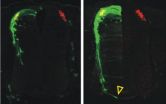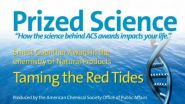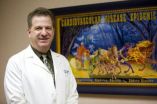(Press-News.org) Both the rate and direction of axon growth in the spinal cord can be controlled, according to new research by USC College's Samantha Butler and her collaborators.
The study, "The Bone Morphogenetic Protein Roof Plate Chemorepellent Regulates the Rate of Commissural Axonal Growth," by Butler; lead researcher Keith Phan and graduate students Virginia Hazen and Michele Frendo of USC College; and Zhengping Jia of the University of Toronto, was published online in the November 17 issue of the Journal of Neuroscience.
Butler, assistant professor of biological sciences, found that a series of connections at the cellular level produce a guidance cue that tells an axon how fast and in which direction to grow in an embryonic environment. Butler and her team also discovered that by modulating the activity of enzyme LIM domain kinase 1 (Limk1), the rate of axon growth can be stalled or accelerated.
Future applications of these findings may include enhancing the ability to regenerate neuronal circuits in patients suffering from spinal cord injuries or neurodegenerative diseases.
Initially, to understand these guidance cues, Butler and her colleagues studied the mechanisms by which neuronal circuits first develop in the embryonic states of rodents and chickens. While researching how an axon is programmed to grow in a particular direction, Butler and her group made a surprising discovery.
"We were expecting that when we perturbed the signaling pathway, the axon would be confused in terms of direction," Butler said. "But we found a much greater effect — the axon grew at a different speed."
Under normal conditions, guidance cues cause a developing neuron to extend an axon into the environment. In a developing spinal cord, the cue comes in the form of a repellant, which acts from behind the cell body to direct the growth of the axon in the opposite direction. This repellant is mediated by bone morphogenetic proteins (BMPs).
In the beginning of the multi-step growth process, BMPs bind to a cell and activate its receptors; then a second messenger is triggered, in this case Limk1. Limk1 modifies the activity of a protein called cofilin. When cofilin is active, the axon grows. If the cofilin becomes inactive, growth comes to a halt.
Butler and her team discovered that by increasing the amount of cofilin, or decreasing the amount of the restricting Limk1, the commissural axon growth accelerated. Likewise, when the amount of cofilin was decreased, or the amount of Limk1 was increased, axon growth stopped.
The axon growth in embryonic spinal cords in which Limk1 was lowered appeared to be more advanced than in controls — the axons grew up to 25 percent faster.
Since the axon is growing through an ever-changing environment, if the accelerated rate moves the axon to its subsequent signal destination too fast, that destination may not yet be created. As a result, growth acceleration can lead to errors in the process, Butler said. She hopes to determine the optimal rate of acceleration that prevents these errors but still supports enhanced regeneration.
"That the growth of axons needs to be controlled in time as well as space is something that is an interesting piece of biology," Butler said. "How it can be applied is very exciting."
Butler sees the application of this research as one part of the process for rebuilding damaged circuits in patients who have sustained spinal cord injuries, or those suffering from Parkinson's or Alzheimer's diseases, possibly using stem-cell-derived therapy. The average rate of axon growth is just 1 mm per day, so any increase would improve a patient's treatment.
"If we knew how to modulate cofilin to maximize the speed of axon growth," Butler said, "perhaps we could shave time off that process of circuit regeneration."
INFORMATION:
Read the full text of the article at http://www.jneurosci.org/cgi/content/full/30/46/15430
Speed heals
USC College's Samantha Butler and collaborators show that the rate and direction of axon growth in the spinal cord can be controlled, a discovery that 1 day may help improve treatment for spinal injuries or neurodegenerative diseases
2010-11-23
ELSE PRESS RELEASES FROM THIS DATE:
New tool detects Ebola, Marburg quickly, easily
2010-11-23
BOSTON (11-22-10) -- Boston University researchers have developed a simple diagnostic tool that can quickly identify dangerous viruses like Ebola and Marburg. The biosensor, which is the size of a quarter and can detect viruses in a blood sample, could be used in developing nations, airports and other places where natural or man-made outbreaks could erupt.
"By enabling ultra-portable and fast detection, our technology can directly impact the course of our reaction against bio-terrorism threats and dramatically improve our capability to confine viral outbreaks," said Assistant ...
Ultrathin alternative to silicon for future electronics
2010-11-23
There's good news in the search for the next generation of semiconductors. Researchers with the U.S. Department of Energy's Lawrence Berkeley National Laboratory (Berkeley Lab) and the University of California (UC) Berkeley, have successfully integrated ultra-thin layers of the semiconductor indium arsenide onto a silicon substrate to create a nanoscale transistor with excellent electronic properties. A member of the III–V family of semiconductors, indium arsenide offers several advantages as an alternative to silicon including superior electron mobility and velocity, ...
Hybrid tugboat cuts emissions, University of California, Riverside study shows
2010-11-23
RIVERSIDE, Calif. (www.ucr.edu) --A new study by University of California, Riverside scientists of what is believed to be the world's only hybrid electric tugboat found that the vessel is effective in reducing emissions at the Ports of Los Angeles and Long Beach.
Researchers at the UC Riverside College of Engineering Center for Environmental Research and Technology (CE-CERT) demonstrated the hybrid electric tugboat reduces emissions of soot by about 73 percent, oxides of nitrogen (which help cause smog) by 51 percent, and carbon dioxide, which contributes to global warming, ...
Overweight primarily a problem among wealthier women in low- to middle-income countries
2010-11-23
Boston, MA – A new study from the Harvard School of Public Health (HSPH) finds that high body mass index (BMI) in developing countries remains primarily a problem of the rich. The findings suggest that the shift towards overweight and obesity among the poor that has already happened in wealthier countries has not yet happened in developing countries.
The study appears in an advance online edition of the American Journal of Clinical Nutrition and will appear in an upcoming print edition.
"Previous research on the increasing overweight and obesity burden in developing countries ...
Mayo Clinic study finds aggressive surgery is best for children with brain tumors
2010-11-23
ROCHESTER, Minn. -- A new Mayo Clinic study (http://newsblog.mayoclinic.org/2008/12/03/brain-tumors-best-treatments-for-long-term-survival/) found that children with low-grade brain tumors (gliomas) (http://www.mayoclinic.org/brain-tumors/) who undergo aggressive surgery to completely remove the tumor have an increased chance of overall survival. If complete removal is not possible, adding radiation therapy to a less complete surgery provides patients with the same outcomes as a complete removal. This study was presented at the Society for NeuroOncology Annual Scientific ...
New American Chemical Society Prized Science video focuses on shrinking the computer chip
2010-11-23
WASHINGTON, Nov. 22, 2010 — The science that helped make today's smartphones and iPods smaller but more powerful than yesterday's desktop computers highlights the latest episode in the American Chemical Society (ACS) Prized Science video series.
The new high-definition video, released today, focuses on IBM chemist Robert Miller, winner of the 2010 ACS Award for Chemistry of Materials. Miller developed materials that helped pack more transistors onto each computer chip, those postage stamp-size slivers of silicon that make up the brains of computers and other electronic ...
University of Minnesota engineering researcher finds new way to fight antibiotic-resistant bacteria
2010-11-23
New findings by civil engineering researchers in the University of Minnesota's College of Science and Engineering shows that treating municipal wastewater solids at higher temperatures may be an effective tool in the fight against antibiotic-resistant bacteria.
Heating the solid waste to 130 degrees Fahrenheit (55 degrees Celsius) was particularly effective in eliminating the genes that confer antibiotic resistance. These genes are used by bacteria to become resistant to multiple antibiotics, which are then known as "superbacteria" or "superbugs."
The research paper ...
The not-so-sweet truth about sugar -- a risk choice?
2010-11-23
More and more people have become aware of the dangers of excessive fructose in diet. A new review on fructose in an upcoming issue of the Journal of the American Society of Nephrology (JASN) indicates just how dangerous this simple sugar may be.
Richard J. Johnson, MD and Takahiko Nakagawa, MD (Division of Renal Diseases and Hypertension, University of Colorado) provide a concise overview of recent clinical and experimental studies to understand how excessive amounts of fructose, present in added sugars, may play a role in high blood pressure, diabetes, obesity, and ...
Perceptual training improves vision of the elderly
2010-11-23
RIVERSIDE, Calif. – Elderly adults can improve their vision with perceptual training, according to a study from the University of California, Riverside and Boston University that has implications for the health and mobility of senior citizens.
The study, "Perceptual learning, aging, and improved visual performance in early stages of visual processing," appears in the current online issue of the Journal of Vision. It was funded by a $3.5 million grant from the National Institute on Aging.
UCR researchers G. John Andersen, professor of psychology; Rui Ni, formerly a postdoctoral ...
HIV drugs interfere with blood sugar, lead to insulin resistance
2010-11-23
The same powerful drugs that have extended the lives of countless people with HIV come with a price – insulin resistance that can lead to diabetes and cardiovascular disease.
Now, researchers at Washington University School of Medicine in St. Louis have determined why that happens. Their research shows that HIV protease inhibitors directly interfere with the way blood sugar levels are controlled in the body. This leads to insulin resistance, a condition that occurs when the body produces enough insulin but doesn't use it properly.
This confirmation provides the potential ...
LAST 30 PRESS RELEASES:
The vast majority of US rivers lack any protections from human activities, new research finds
Ultrasound-responsive in situ antigen "nanocatchers" open a new paradigm for personalized tumor immunotherapy
Environmental “superbugs” in our rivers and soils: new one health review warns of growing antimicrobial resistance crisis
Triple threat in greenhouse farming: how heavy metals, microplastics, and antibiotic resistance genes unite to challenge sustainable food production
Earthworms turn manure into a powerful tool against antibiotic resistance
AI turns water into an early warning network for hidden biological pollutants
Hidden hotspots on “green” plastics: biodegradable and conventional plastics shape very different antibiotic resistance risks in river microbiomes
Engineered biochar enzyme system clears toxic phenolic acids and restores pepper seed germination in continuous cropping soils
Retail therapy fail? Online shopping linked to stress, says study
How well-meaning allies can increase stress for marginalized people
Commercially viable biomanufacturing: designer yeast turns sugar into lucrative chemical 3-HP
Control valve discovered in gut’s plumbing system
George Mason University leads phase 2 clinical trial for pill to help maintain weight loss after GLP-1s
Hop to it: research from Shedd Aquarium tracks conch movement to set new conservation guidance
Weight loss drugs and bariatric surgery improve the body’s fat ‘balance:’ study
The Age of Fishes began with mass death
TB harnesses part of immune defense system to cause infection
Important new source of oxidation in the atmosphere found
A tug-of-war explains a decades-old question about how bacteria swim
Strengthened immune defense against cancer
Engineering the development of the pancreas
The Journal of Nuclear Medicine ahead-of-print tip sheet: Jan. 9, 2026
Mount Sinai researchers help create largest immune cell atlas of bone marrow in multiple myeloma patients
Why it is so hard to get started on an unpleasant task: Scientists identify a “motivation brake”
Body composition changes after bariatric surgery or treatment with GLP-1 receptor agonists
Targeted regulation of abortion providers laws and pregnancies conceived through fertility treatment
Press registration is now open for the 2026 ACMG Annual Clinical Genetics Meeting
Understanding sex-based differences and the role of bone morphogenetic protein signaling in Alzheimer’s disease
Breakthrough in thin-film electrolytes pushes solid oxide fuel cells forward
Clues from the past reveal the West Antarctic Ice Sheet’s vulnerability to warming
[Press-News.org] Speed healsUSC College's Samantha Butler and collaborators show that the rate and direction of axon growth in the spinal cord can be controlled, a discovery that 1 day may help improve treatment for spinal injuries or neurodegenerative diseases


